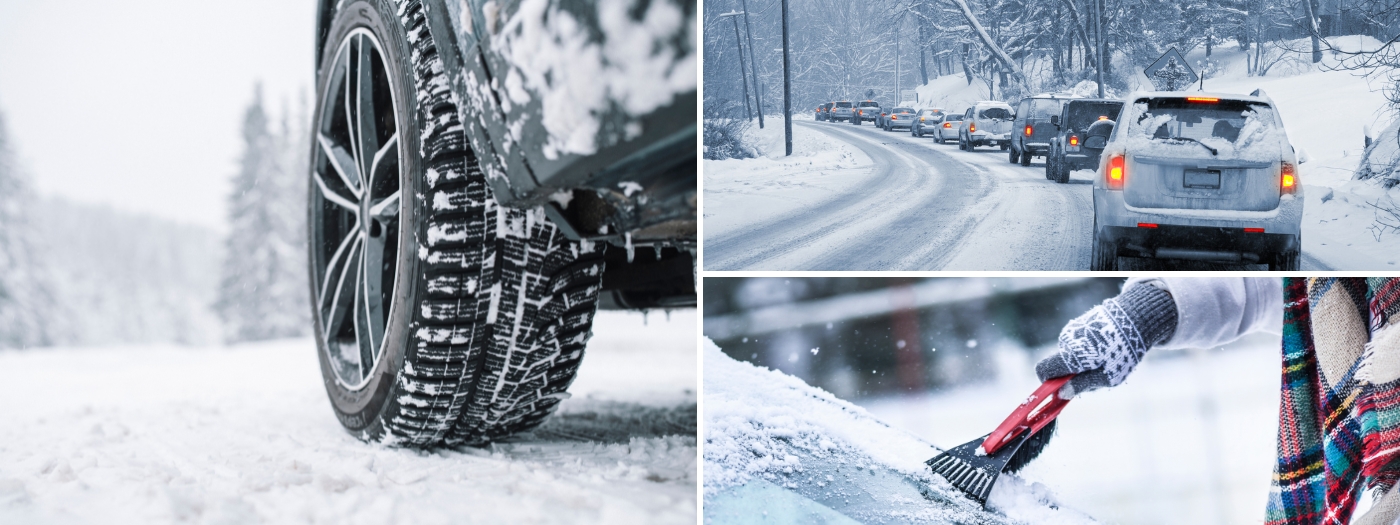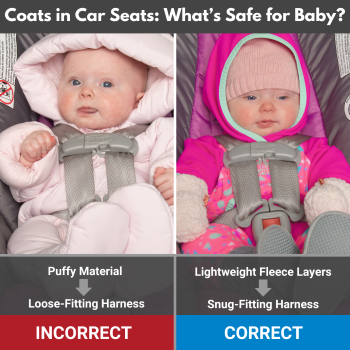
Whether it’s snow, sleet or ice, winter weather can cause extremely dangerous road conditions. In 2021 there were 395 fatal crashes, and an estimated 22,325 injury crashes that occurred when there was snow/sleet conditions at the time of the crash. Preparing yourself – and your vehicle – for winter weather is key.
Watch the videoSlow down. It’s harder to control or stop your vehicle on a slick or snow-covered surface. In fact, in 2021, there were an estimated 121,156 police-reported crashes that occurred when there was snow/sleet conditions at the time of the crash. On the road, increase your following distance enough so that you’ll have plenty of time to stop for vehicles ahead of you.
Don’t crowd a snow plow or travel beside the truck. Snow plows travel slowly, make wide turns, stop often, overlap lanes, and exit the road frequently. If you find yourself behind a snow plow, stay far enough behind it and use caution if you pass the plow.
If you are stopped or stalled in wintry weather, stay focused on yourself and your passengers, your car, and your surroundings.

As the outside temperature drops, so does tire inflation pressure. Make sure each tire is filled to the vehicle manufacturer’s recommended inflation pressure, which is in your owner’s manual and on a label located on the driver's side door frame. Do not inflate your tires to the pressure listed on the tire itself. That number is the maximum pressure the tire can hold, not the recommended pressure for the your vehicle.
Some other tips:
An inspection is not just about checking tire pressure and age. Remember to check:
If you find tire damage, take your vehicle to a tire service professional.
Consider installing snow tires, but before buying new tires, visit NHTSA’s Tires page to review tire safety ratings. The Uniform Tire Quality Grading System (UTQGS) lets you compare tire treadwear, traction performance, and temperature resistance.

In colder weather, parents typically dress their children in winter coats. But it’s important to know that heavy coats can interfere with the proper harness fit on a child in a car seat. When your child will be secured in a car seat, pick thin, warm layers, and place blankets or coats around your child after the harness is snug and secure for extra warmth.
Also, make sure car seats and booster seats are properly installed and that any children riding with you are in the right seat for their ages and sizes. See NHTSA’s child passenger safety recommendations to find the right seat for your child’s age and size. You can visit NHTSA’s Child Car Seat Inspection Station Locator to find a free car seat inspection site near you, or to get information on virtual inspections.
When the temperature drops, so does battery power. In cold weather, gasoline and diesel engines take more battery power to start, and electric and hybrid-electric vehicles’ driving range can be reduced. Have a mechanic check your battery, charging system, belts, and for any other needed repairs or replacements.
Familiarize yourself with the safety technologies on your vehicle and how they perform in wintry conditions. Know whether your vehicle has an antilock brake system and learn how to use it properly. Antilock brake systems prevent your wheels from locking up during braking. If you have antilock brakes, apply firm, continuous pressure to the brake pedal. If you don’t have antilock brakes, you may need to pump your brakes if you feel your wheels starting to lock up. For more information on driver assistance technologies, visit NHTSA.gov/DriverAssistTech.
Due to slushy winter conditions, you might consider switching out your usual floor mats for thicker material or rubbery ones. Improperly installed floor mats in your vehicle could interfere with the operation of the accelerator or brake pedal, increasing the risk of a crash. Follow the manufacturer’s instructions for mat installation and use retention clips to secure the mats. Always use mats that are the correct size and fit for your vehicle.
Check your headlights, brake lights, turn signals, emergency flashers and interior lights. Be sure to also check your trailer brake lights and turn signals, if necessary.
You can quickly go through a lot of windshield wiper fluid in a single snowstorm. Make sure your vehicle’s reservoir is full of high-quality “winter” fluid with de-icer before winter weather hits. Make sure defrosters and all windshield wipers work and replace any worn blades. Consider installing heavy-duty winter wipers if you live in an area that gets a lot of snow and ice.
Make sure you have enough coolant in your vehicle, and that it meets the manufacturer’s specifications. See your vehicle owner’s manual for recommendations. Check the cooling system for leaks, test the coolant, and drain or replace the old coolant.
You may also want to visit your mechanic for a tune-up and ask them to check for leaks, badly worn hoses, or other needed parts, repairs, and replacements.
Carry items in your vehicle to handle common winter driving-related tasks, and supplies you might need in an emergency, including:
Keep your gas tank close to full whenever possible.
Similarly, in the case for electric and hybrid-electric vehicles, it is important keep your battery charged and to also minimize the drain on the battery. In general, batteries with liquid electrolyte have reduced energy storage and delivery capabilities at lower temperatures, which is why most all vehicle batteries use battery power for self-heating in low temperatures. The battery drain due to heating can be minimized by keeping your electric vehicle as warm as possible during freezing temperatures. A common way to do this is plugging your vehicle in at night during the winter – keeping the battery in its optimal temperature ranges.
Check your local weather and traffic reports before heading out. If your roads are not in good shape, consider postponing non-essential travel until the roads are cleared. If you do have to go out, make sure you are prepared in case you become delayed while traveling. If making a long road trip when winter weather is forecasted, consider leaving early or changing your departure to avoid being on the roads during the worst of the storm.
Familiarize yourself with directions and maps before you go—even if you use a GPS—and let others know your route and anticipated arrival time. On longer trips, plan enough time to stop to stretch, get something to eat, check your phone, and change drivers or rest if you feel drowsy.
NHTSA's Recalls Look-up Tool lets you enter a vehicle identification number (VIN) to quickly learn if your vehicle has a critical safety issue that has not been repaired, and how to get that repair done for free. You can also download NHTSA’s SaferCar app and enter your vehicle and equipment information. If a recall is issued, you’ll get an alert on your phone.
You know the rules: Do not text or drive distracted; obey posted speed limits; and always drive sober. Both alcohol and drugs can impair safe and responsible driving by affecting things such as coordination, judgment, perception, and reaction time. And remember: always wear your seat belt.
Winter Weather Driving Tips